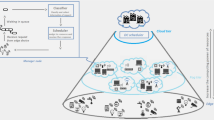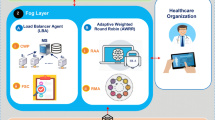Abstract
On the fly deployment of fog nodes near users provides the flexibility of pushing services anywhere and whenever needed. Nevertheless, taking a real-life scenario, the cloud might limit the number of fogs to place for minimizing the complexity of monitoring a large number of fogs and cost for volunteers that do not offer their resources for free. This implies choosing the right time and best volunteer to create a fog which the cloud can benefit from is essential. This choice is subject to study the demand of a particular location for services in order to maximize the resources utilization of these fogs. A simple algorithm will not be able to explore randomly changing users’ demands. Therefore, there is a need for an intelligent model capable of scheduling fog placement based on the user’s requests. In this paper, we propose a Fog Scheduling Decision model based on reinforcement R-learning, which focuses on studying the behavior of service requesters and produces a suitable fog placement schedule based on the concept of average reward. Our model aims to decrease the cloud’s load by utilizing the maximum available fogs resources over different locations. An implementation of our proposed R-learning model is provided in the paper, followed by a series of experiments on a real dataset to prove its efficiency in utilizing fog resources and minimizing the cloud’s load. We also demonstrate the ability of our model to improve over time by adapting the new demand of users. Experiments comparing the decisions of our model with two other potential fog placement approaches used for task/service scheduling (threshold based and random based) show that the number of processed requests performed by the cloud decreases from 100 to 30% with a limited number of fogs to push. These results demonstrate that our proposed Fog Scheduling Decision model plays a crucial role in the placement of the on-demand fog to the right location at the right time while taking into account the user’s needs.




Similar content being viewed by others
References
Patel KK, Patel SM et al (2016) Internet of things-IOT: definition, characteristics, architecture, enabling technologies, application and future challenges. Int J Eng Sci Comput 6(5):6122–6131
Gubbi J, Buyya R, Marusic S, Palaniswami M (2013) Internet of things (IOT): a vision, architectural elements, and future directions. Future Gener Comput Syst 29:1645–1660
Alberti AM, Singh D (2013) Internet of things: perspectives, challenges and opportunities. In: International Workshop on Telecommunications (IWT 2013), pp 1–6
Tordera E M, Masip-Bruin X, Garcia-Alminana J, Jukan A, Ren G-J, Zhu J, Farré J (2016) What is a fog node a tutorial on current concepts towards a common definition. arXiv preprint arXiv:1611.09193
Bonomi F, Milito R, Zhu J, Addepalli S (2012) Fog computing and its role in the internet of things. In: Proceedings of the First Edition of the MCC Workshop on Mobile Cloud Computing. ACM, pp 1–6
Sami H, Mourad A (2018) Towards dynamic on-demand fog computing formation based on containerization technology. In: Proceedings of the 2018 International Conference on Computational Science and Computational Intelligence–CSCI’18. IEEE Computer Society
Kratzke N (2017) About microservices, containers and their underestimated impact on network performance. arXiv preprint arXiv:1710.04049
Sayfan G (2017) Mastering kubernetes. Packt Publishing Ltd, Birmingham
Fatema K, Emeakaroha VC, Healy PD, Morrison JP, Lynn T (2014) A survey of cloud monitoring tools: taxonomy, capabilities and objectives. J Parallel Distrib Comput 74(10):2918–2933
Roman R, Lopez J, Mambo M (2018) Mobile edge computing, fog et al.: a survey and analysis of security threats and challenges. Future Gener Comput Syst 78:680–698
Yi S, Li C, Li Q (2015) A survey of fog computing: concepts, applications and issues. In: Proceedings of the 2015 Workshop on Mobile Big Data. ACM, pp 37–42
Gosavi A et al (2015) Simulation-based optimization. Springer, Berlin
Watkins CJ, Dayan P (1992) Q-learning. Mach Learn 8(3–4):279–292
Nasa dataset-two months of http logs from a busy www server. [Online]. https://ita.ee.lbl.gov/html/traces.html
Hao Z, Novak E, Yi S, Li Q (2017) Challenges and software architecture for fog computing. IEEE Internet Comput 21(2):44–53
Mahmud R, Kotagiri R, Buyya R (2018) Fog computing: a taxonomy, survey and future directions. In: Internet of everything. Springer, pp 103–130
Tout H, Talhi C, Kara N, Mourad A (2017) Smart mobile computation offloading: centralized selective and multi-objective approach. Expert Syst Appl 80:1–13
Marrouche W, Harmanani HM (2018) Heuristic approaches for the open-shop scheduling problem. In: Information Technology-New Generations. Springer, pp 691–699
Dbouk T, Mourad A, Otrok H, Tout H, Talhi C (2019) A novel ad-hoc mobile edge cloud offering security services through intelligent resource-aware offloading. IEEE Trans Netw Serv Manag. https://doi.org/10.1109/TNSM.2019.2939221
Chen M, Hao Y (2018) Task offloading for mobile edge computing in software defined ultra-dense network. IEEE J Sel Areas Commun 36(3):587–597
Zhang J, Hu X, Ning Z, Ngai EC-H, Zhou L, Wei J, Cheng J, Hu B (2017) Energy-latency tradeoff for energy-aware offloading in mobile edge computing networks. IEEE Internet Things J 5(4):2633–2645
Pham X-Q, Man ND, Tri NDT, Thai NQ, Huh E-N (2017) A cost-and performance-effective approach for task scheduling based on collaboration between cloud and fog computing. Int J Distrib Sens Netw 13(11):1550147717742073
Pham X-Q, Huh E-N (2016) Towards task scheduling in a cloud-fog computing system. In: 18th Asia-Pacific Network Operations and Management Symposium (APNOMS). IEEE, pp 1–4
Zeng D, Gu L, Guo S, Cheng Z, Yu S (2016) Joint optimization of task scheduling and image placement in fog computing supported software-defined embedded system. IEEE Trans Comput 65(12):3702–3712
Kherraf N, Alameddine HA, Sharafeddine S, Assi C, Ghrayeb A (2019) Optimized provisioning of edge computing resources with heterogeneous workload in iot networks. IEEE Trans Netw Serv Manag 16(5):459–474
Alameddine HA, Sharafeddine S, Sebbah S, Ayoubi S, Assi C (2019) Dynamic task offloading and scheduling for low-latency iot services in multi-access edge computing. IEEE J Sel Areas Commun 37(3):668–682
Yousefpour A, Ishigaki G, Jue J P (2017) Fog computing: Towards minimizing delay in the internet of things. In: 2017 IEEE International Conference on Edge Computing (EDGE). IEEE, pp 17–24
Hoque S, de Brito M S, Willner A, Keil O, Magedanz T (2017) Towards container orchestration in fog computing infrastructures. In: Proceedings of the (2017) IEEE 41st Annual on Computer Software and Applications Conference (COMPSAC), vol 2. IEEE, pp 294–299
Felter W, Ferreira A, Rajamony R, Rubio J (2015) An updated performance comparison of virtual machines and linux containers. In: 2015 IEEE International Symposium Performance on Analysis of Systems and Software (ISPASS). IEEE
Hong H-J, Tsai P-H, Hsu C-H (2016) “Dynamic module deployment in a fog computing platform. In: 18th Asia-Pacific on Network Operations and Management Symposium (APNOMS). IEEE, pp 1–6
Knox WB, Setapen AB, Stone P (2011) Reinforcement learning with human feedback in mountain car. In: 2011 AAAI Spring Symposium Series
Gosavi A (2011) A tutorial for reinforcement learning. Department of Engineering Management and Systems Engineering
Skarlat O, Nardelli M, Schulte S, Borkowski M, Leitner P (2017) Optimized iot service placement in the fog. Serv Oriented Comput Appl 11(4):427–443
Author information
Authors and Affiliations
Corresponding author
Additional information
Publisher's Note
Springer Nature remains neutral with regard to jurisdictional claims in published maps and institutional affiliations.
Rights and permissions
About this article
Cite this article
Farhat, P., Sami, H. & Mourad, A. Reinforcement R-learning model for time scheduling of on-demand fog placement. J Supercomput 76, 388–410 (2020). https://doi.org/10.1007/s11227-019-03032-z
Published:
Issue Date:
DOI: https://doi.org/10.1007/s11227-019-03032-z




